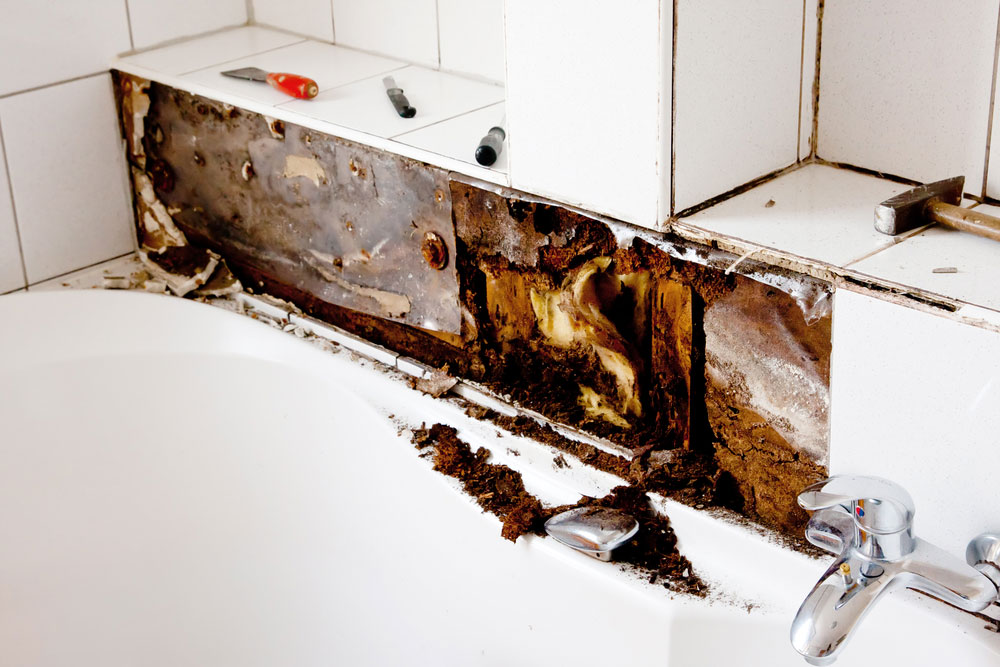The article following next involving How to Prevent Bathroom Water Damage is particularly insightful. You should give it a look.

The restroom is extremely vulnerable for wet buildup and also potential water damages as a result of the regular use water in it. This post provides simple examination methods to help spotting water damage hazards.
The frequent use of water in the restroom makes it very susceptible for damp build-up and potential water damage. By inspecting it routinely, you can reduce water related damages.
The following set of inspections is easy to execute and also must be done once in every three months in order to keep your bathroom healthy and also to stop prospective water problems triggered by the tub, the shower, pipe joints and plumbing, sinks, cabinets, and also the bathroom
Do not overlook carrying out these evaluations and be thorough while performing them. Remember that these straightforward assessments can save you a lot of cash by supplying early indicators for water damage
Bathtub and Shower
The shower and also tub need special focus and also maintenance. Check the tiles and also replace if fractured. Make certain that there is no missing cement in between the tiles. Evaluate as well as replace split caulking at joints where the walls fulfill the floor or the bath tub. Blocked drains pipes and pipelines problems will certainly avoid the bath tub from drying out and might suggest major troubles underneath the bathtub. Seek advice from a professional quickly to stop structural damages. Pay attention to stainings or soft areas around the tub wall surfaces as they may show an internal leakage.
Plumbing
Signs for water damage are difficult to identify because the majority of pipes are mounted inside the walls.
Pay unique focus to flooring and also walls wetness and also stains as they may suggest an invisible plumbing problem. Inspect dampness levels in adjacent areas as well.
Sinks as well as Cabinets
Sinks and also cabinets are subjected to dampness and also moisture everyday and also are frequently forgotten. Evaluate routinely under the sink as well as on the kitchen counter above it. Repair any type of drip in the catch as it might suggest drain problems. Browse the sink, sluggish draining pipelines might indicate a blocked drainpipe. Change sink seals if they are fractured or loose.
The Toilet
The bathroom is a prone water joint. Examine the water lines and also look for leakages around the toilet seat, in the pipe, and also under the water storage tank. If you identify any indications of moisture on the floor around the commode, check for leaks in the toilet rim and also tank seals.
Be aware that hanging toilet bowl deodorants enhances the possibilities for blockages.
Water Damage Signs In The Bathroom To Avoid Cleanup
Musty smell
This is one of the easiest signs to catch because musty smells are so odorous. The damp, earthy, moldy smell should be a big red flag. The smell will develop when moisture gets trapped in surfaces, and begins to facilitate mold growth. Leaking pipes under cabinets, inside walls, and behind shower fixtures will cause moisture to stay trapped and not dry, which will lead to mold growth and spread. As soon as you notice any musty smells in your bathroom, have it checked for hidden water damage and cleanup signs.
Visible mold
If the smell isn’t there to give it away, sometimes you will actually see mold growth. Finding mold in your bathroom is a serious problem, because mold is very harmful to your health. By the time mold growth is visible, it also means that water damage has already occurred and been present for some time. The only way the mold problem can be resolved is to find the source of the moisture and get it stopped. To safely and adequately remove mold, you need to have professionals handle the remediation. Do not waste any time in getting mold problems addressed, fixed, and sanitized so that you can protect you and your family from the many respiratory symptoms caused by mold exposure.
Damaged floors
Bathroom floors should be able to withstand some exposure to water while still remaining in good condition. However, when excess exposure or water leaks occur, they will begin to damage even the most water-resistant flooring. If you notice any cracking, bubbling, staining, or warping on your bathroom floors, there is probably a water leak somewhere causing the distortion. If you notice areas of the floor have become softer, or even have a spongy feeling, there is probably damage to the subfloor. Subflooring is typically made up of plywood. When plywood is exposed to water or moisture, it will absorb it. Once it has become saturated, the weight of the excess water will cause the wood to swell and soften. Check the floors in your bathroom frequently to catch any of these sings before they lead to damaged subflooring.
Changes on walls
When water leaks behind walls, it will cause changes in the drywall. Peeling plaster, blistering paint, and soggy wallpaper are all good indicators that excess water is building up behind the wall. Water leaking behind drywall will cause it to swell and be soft to the tough. If you start to notice gaps along the trim of your walls, or where tile meets the wall, it could also be a strong indicator that there is a leak behind the wall. Any changes, distortion, or damage on the walls should be evaluated as soon as you notice it to prevent further water damage and cleanup.

I am very eager about Common Causes of Water Damage in a Bathroom and I'm hoping you appreciated our blog post. Are you aware of another person who is inquisitive about the subject? Why not share it. We cherish reading our article about How to Repair and Prevent Bathroom Water Damage.
Call Us Now